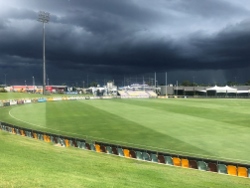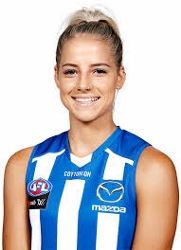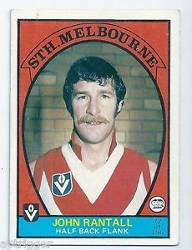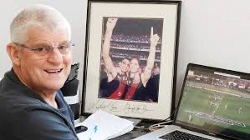Cairns Footy A Shining Light - Pt.2
- Saturday, July 13 2019 @ 04:00 pm ACST
- Contributed by: Wesley Hull
- Views: 3,630


Earlier this year World Footy News released a story looking at how the northern city would cope, in a footy sense, having lost their annual AFL match which they had held since 2011. Over that time, eight matches were played at Cazalys Stadium featuring the Gold Coast Suns, Richmond, Western Bulldogs and most recently North Melbourne.
This was in addition to a VFL match between the Suns and Bendigo Bombers in 2010 and pre-season cup matches stretching back to the turn of the century.
Our story featured interviews with past players from VFL/AFL days who either played, coached or officiated in Cairns – former Blue and Bulldog, Max O’Halloran, Collingwood great Ronnie Wearmouth, recent Essendon player Courtenay Dempsey and current Suns’ star Jack Bowes. (See Cairns Footy Still A Shining Light)
For the record, my own role has seen me coaching and playing in Cairns since 2000. Over that time, the increased presence of AFL teams has spilled over into junior development in a big way. At the height of the matches, Nick Malceski (Swans), Liam Picken, Jordon Roughead, Lochie Hunter, Will Minson and more dropped in to our Pyramid Power club in Gordonvale to the delight of the kids, joining in drills and signing autographs.
Not connected to those matches, but still part of the fervour, the great Adam Goodes dropped by as did Demon Jay Kennedy Harris. That was just our team – it was multiplied over all AFL Cairns clubs.
I was able to personally interview Malcolm Blight, Guy McKenna, Mitch Wallis, Jason Johannison, Brian Royal and sit in on coaching seminars held by Tom Hafey, Luke Beveridge, Justin Leppitsch, Matthew Primus and more. Yes, this is name-dropping, but it highlighted how close the Cairns community could get to AFL stars past and present. It was palpable, and the flow-on excitement went to the kids.
My own Gordonvale State School girl’s team twice played the feature half-time entertainment Auskick match representing the Gold Coast Suns colours and being cheered of the ground to the high-fives of a 9000 strong crowd one year, and running up the race beside the Bulldogs players the other. Not so suddenly, the AFL had come to Cairns and the momentum was huge.
Then, in 2018, nature stepped in to almost wash out the Round 1 Suns v Kangaroos match, and no new contract was forthcoming. The AFL gave the match instead to rival city, Townsville, and it will be mighty hard to get it back again.
It raises the question as to the impacts the loss of the game will have on local growth. It is too early to tell, but those interviewed in our story had various points of view, as do those interviewed for this story – rising North Melbourne AFLW player Elisha King, former games record holder and Hall Of Fame player John Rantall and former Richmond, Collingwood and Essendon recruiting guru Noel Judkins.
 Elisha King (North Melbourne)
Elisha King (North Melbourne)
Elisha has been a true trailblazer for women’s footy up in Cairns since her primary school days. As such, Elisha represents a very important part of the footy fabric in the north of the country.
“I started playing footy at age five. I played junior footy with Manunda Hawks and then went to the women’s league with Cairns North. My brothers, Aaron and Hayden, were playing footy so I decided to join as well and have loved it ever since.”
“[Along the way] I played for the Cairns Lions Under 18 representitive team at age of 13 from where I was selected in the Queensland team. I represented Queensland for five years and made the All-Australian team at age 15. I also represented the Cairns Lions boys Under 14 team – the first female to do this. I won the league Under 12 Best and Fairest and was also the first female to do this.”
Elisha has had a good look at the development pathways available in Cairns over many years. “Talent pathways have come a long way in Cairns. Having the Suns Academy up here has been a huge success. Since Jack Bowes, there has been a few boys that have made the move to the Gold Coast to follow their dreams and have made it onto an AFL List. Now that they are offering this to the girls is fantastic.”
“I think that it will have an impact by losing a game here as the kids love to watch their favourite players running around and it gives them something to work/strive towards. However, I think footy in Cairns is heading in the right direction because of the relationship with the Suns and the academy programs that are being offered."
“One of my proudest moment would have to be was when I won the League Best and Fairest award because it had never been won by a girl before and in that year I tried out for Peninsula and was told that I wasn't good enough. I was also awarded selection in the All Australian teams at both club level and School sport level.”
“Having my parents backing me in all the sports that I've played has had a huge influence. I have represented Peninsula, Cairns, Queensland and Australia in many sports - AFL, Hockey, Futsal, Basketball, Athletics and Cross Country. The dedication [of my family] to take me to all the trainings and funding all the trips has played a huge part in where I am now.”
 John Rantall (South Melbourne, North Melbourne, Fitzroy)
John Rantall (South Melbourne, North Melbourne, Fitzroy)
When John “Mopsy” Rantall broke Kevin Murray’s games record back in 1980, his 336 games was briefly seen as a mountain difficult to climb. However, by the finals that same year Kevin Bartlett usurped Rantall. However, the record he set shows his longevity and value to the game.
Since then, Rantall’s journey has taken him many places and many roles within AFL ranks as well as being a keen observer of the game’s development. He spent many years involved with AFL Cairns and saw much change.
Rantall says that “from 1999 to 2008 Cairns [footy] grew famously and made huge inroads. Allen Aylett encouraged Reg Lillywhite (AFL Cairns president and vice-president across generations from the 70’s onwards) to chase the [freehold] land [where Cazalys Stadium now stands]. Allen had the vision and Reg Lillywhite pushed to make it happen.” Rantall believes that the succession of great, visionary leaders such as Lillywhite, Ted Hopgood, Russell Beer and Max O’Halloran drove the game to provide a world class venue capable of hosting the best in sport.
However, Rantall sees the loss of the annual premiership match as a blow. He sees the branding of the game as “not as good as it used to be” and that AFL Cairns “will have a fight on its hands to preserve what they now have”. He believes it will be harder to sell the code as “number one” option given that “there are a lot more sporting options available to kids than when we were young”.
Rantall knows how important it is to keep “hacking away” to stay in the public eye. During his time involved with the Hampden League in Victoria, one club “had a very hard ground and the town realised that it had to spend 5-6 million to redevelop the ground” and make it viable. They did this by trying to “keep this [story] on the front page and on the back page to make people aware”.
He believes AFL Cairns need to follow the same lines. “Keep trying, not give up, keep fighting”. He also believes that the league needs to keep looking at other options. “Look further, don’t stop looking. Clever clubs [and leagues] survive. Amalgamations are inevitable”. He is excited at the prospect of potential carnivals to the city, a possible NEAFL connection and even possibly exploring a team in the NTFL. All would offset the loss of the premiership match.
 Noel Judkins (Essendon, Richmond, Collingwood recruiter)
Noel Judkins (Essendon, Richmond, Collingwood recruiter)
Born into football royalty, Noel Judkins admits he “was born and bred into footy”. His father, Stan Judkins, played 130 games for Richmond and won the 1930 Brownlow Medal. Footy was so ingrained that he would pick teams from age seven and even spent time picking his Dad’s Richmond teams for fun.
Noel followed this football journey through junior footy and school comps, eventually playing for East Sandringham Under 15’s. By 1963 he was at Richmond himself, coached by a legend in Ray “Slug” Jordan but eventually “got the flick” after a broken ankle and found his way to Mordialloc where he started to hone his skills in identifying talent. Working with former Geelong player Geoff Rosenow, they asked for three years to win a flag back in 1974 and by 1977 it happened. His astute skills in finding talent helped grow a great team. His success caught Richmond’s eye again, in a different role – recruitment and club management.
“I remember Graeme Richmond’s words to this day” recalled Noel. “He said ‘By Christ! You’ve done a great job down there at Mordialloc, do you want to come to Richmond’”.
From there he saw from close range Kevin Sheedy’s moves to eventually become Essendon coach, and “in 1980 said he was looking for a full time recruiter. They wanted to get rid of ‘form 4’s’ and he knew a national competition was coming and the draft. I said no but I went to Essendon for a meeting on a Thursday. Greg Sewell offered me the job. I spoke to my dad about leaving and he said Essendon was a good club. I resigned [from Richmond] and joined the Bombers.” The rest is history.
Judkins went on to identify and recruit some of Essendon’s greatest players in Michael Long, Leon Baker, Gavin Wanganeen and James Hird – and plenty more. When he left the Bombers for Collingwood in the late 90’s he kept going, identifying future stars like Dane Swan.
Since those days he has travelled around and been living on Cairns northern beaches for nine years. These days he still assists Essendon, helping their current recruiting manager Adrian Dodoro to keep finding talent. He still has the eye for what will work.
The two big skills for Judkins are players “prepared to get their own ball”, but above all “to have clean hands and not fumble the ball. Kicking [as a skill] is number two because if you fumble the ball you can’t kick it.” He cites Kevin Sheedy as an example. “At Melbourne Grammar kids came from all over Australia in 1979. Sheedy would stand 10 metres in front of these kids and fire his “rocket hands” handpass at them. He told them he was slow and he wasn’t a big kick, but he DIDN’T fumble the ball.” He also cited players such as Greg “Diesel” Williams (Sydney, Geelong, Carlton) and Sam Mitchell (Hawthorn) as slow players but they didn’t fumble.
Noel concedes that Cairns losing the annual premiership match will have an impact but it isn’t irreversible. “You can either complain or do something about it” he said, and cited recent investigations into a possible NTFL or NEAFL team as positive steps forward for AFL Cairns.
He was also interested to hear of the success of AFL Cape York House and their work with indigenous youth as a way to tap talent via pathways. He also felt that work done by Pyramid Power and other clubs to find alternate pathways through southern (Victoria, South Australia) clubs for their indigenous players and bypassing the academy network as another creative step forward.
The word of a full-time Gold Coast Suns Academy staff member being based in Cairns also offered opportunities. With all of these options combined, it makes it easier to market opportunities to families and potential players and grow the game. That, combined with having a regional team based in interstate competition, would attract more higher profile talents would see growth without needing a premiership match played in the city.
He also says that a change in mentality about the value of school footy would be a positive change. “about 10 years ago in Tasmania they stopped [prioritising] footy in schools. Footy dropped away and teams dropped away”. It is no coincidence that Tasmania experienced a period where fewer players from the state were drafted.
Noel suggests that clubs should “buy or access money to give every kid a footy in the younger age groups. They will take the footy home and play with their mates. They get their mates involved – maybe four or five mates - and you get more kids playing footy.” Expanding this idea to schools could see even more kids taking up the game.
“Losing the match in Cairns was unlucky because of the weather – the ball was like playing with a cake of soap, especially in the first half. Backers won’t back wet conditions, so [in retrospect] choosing round one was probably a bad choice”.
However, Judkins also believes that there are other ways to grow the game. “AFL Cairns is the richest competition in Australia through good management over the years. They own the land [Cazalys Stadium] freehold and have assets. Get a Gold Coast Suns Academy rep visiting schools regularly. Sheedy said that every player needed a footy – he believed that they should have 500 kicks each foot and 500 handpasses each hand before drills. At Essendon players walked through the corridors bouncing footys – Long, Wanganeen.”
His image would be for as many kids as possible having footys and embracing the game with their mates – potentially more valuable that a premiership match for attracting new players.


 RSS news
RSS news Twitter
Twitter Facebook
Facebook